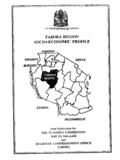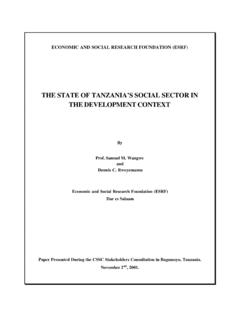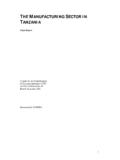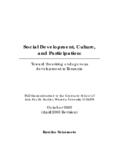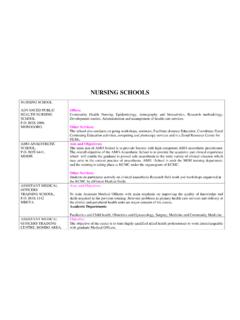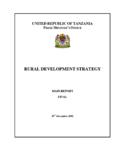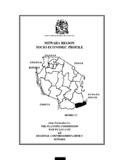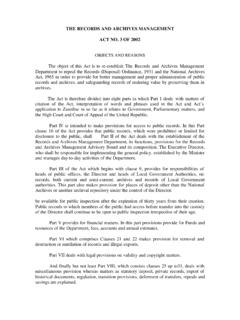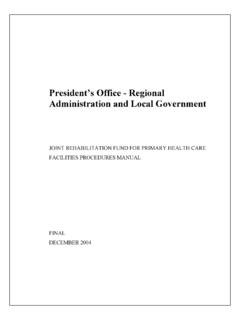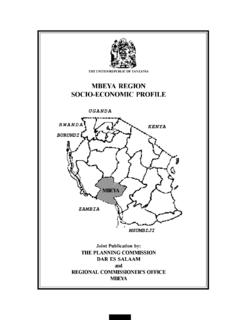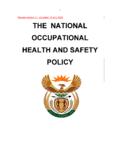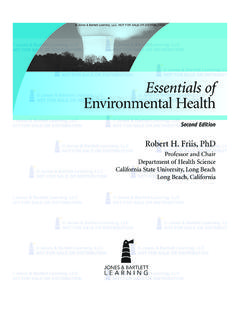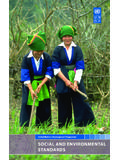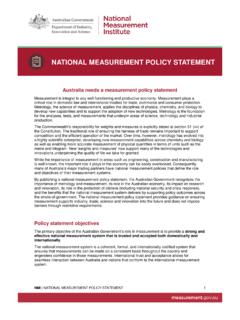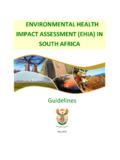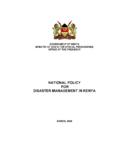Transcription of NATIONAL WATER POLICY - Tanzania Online …
1 NATIONAL WATER POLICY THE UNITED REPUBLIC OF Tanzania . MINISTRY OF WATER AND LIVESTOCK. DEVELOPMENT. NATIONAL . WATER POLICY . July 2002. NATIONAL WATER POLICY Page ii NATIONAL WATER POLICY ACRONYMS AND ABBREVIATIONS. Tv t w Tuu x |t | . CBOs Community Based Organizations DRA Demand Responsive Approach EIA Environmental Impact Assessment ESAs External Support Agencies EWURA Energy and WATER Utilities Regulatory Authority GDP Gross Domestic Product l/s/km2 litres per second per square kilometre m3/h Cubic Meters per Hour MIS Management Information System NGO Non Governmental Organization O&M Operation and Maintenance PRSP Poverty Reduction Strategy Paper PSP Private Sector Participation RWS Rural WATER Supply UN United Nations UNCED United Nation Conference on Environment and Development UWSAs Urban WATER Supply Authorities UWSS Urban WATER Supply and Sewerage WRM WATER Resources Management WSS WATER Supply and Sewerage Page iii NATIONAL WATER POLICY Page iv NATIONAL WATER POLICY TABLE OF CONTENTS.
2 ACRONYMS AND ABBREVIATIONS - - - - - - - - - - - - - - - - - - iii INTRODUCTION - - - - - - - - - - - - - - - - - - - - - - - - - - - - - - - -1. SECTION I: WATER RESOURCES MANAGEMENT - - - - - - - - - - - - - 8. gtu x y V x . 1. OVERVIEW -------------------------------8. WATER Resources Potential - - - - - - - - - - - - - - - - - - - - 8. WATER Resources Depletion - - - - - - - - - - - - - - - - - - 11. Present WATER Resources Management System - - - 11. 2. WATER AND NATIONAL . SOCIO-ECONOMIC DEVELOPMENT - - - - - - - - - - - - - 12. Domestic WATER Supply - - - - - - - - - - - - - - - - - - - - - 12. Livestock - - - - - - - - - - - - - - - - - - - - - - - - - - - - - - - - 12. Agriculture - - - - - - - - - - - - - - - - - - - - - - - - - - - - - - 13. Industry - - - - - - - - - - - - - - - - - - - - - - - - - - - - - - - - - 14. Mining - - - - - - - - - - - - - - - - - - - - - - - - - - - - - - - - - - 15. Energy - - - - - - - - - - - - - - - - - - - - - - - - - - - - - - - - - 15.
3 Fisheries - - - - - - - - - - - - - - - - - - - - - - - - - - - - - - - - -16. Environment - - - - - - - - - - - - - - - - - - - - - - - - - - - - 16. Wildlife and Tourism - - - - - - - - - - - - - - - - - - - - - - - - 17. Forestry and Beekeeping - - - - - - - - - - - - - - - - - - - - 18. Navigation - - - - - - - - - - - - - - - - - - - - - - - - - - - - - - 18. Transboundary WATER Resources - - - - - - - - - - - - - - 18. 3. CHALLENGES IN WATER . RESOURCES MANAGEMENT - - - - - - - - - - - - - - - - - - - 19. WATER Resources Management Challenges - - - - - - 19. Rationale for Integrated WATER Resources - - - - - - - 20. Main POLICY Principles in WATER Resources Management - - - - - - - - - - - - - - - - - - - - - - - - - - - - 22. 4. POLICY ISSUES IN WATER RESOURCES MANAGEMENT - - 25. WATER Resources Allocation, Use and Socio Economic Considerations - - - - - - - - - - - - - - - 26. Page v NATIONAL WATER POLICY WATER Conservation, WATER Quality Management and Pollution Control - - - - - - 29.
4 WATER and the Environment - - - - - - - - - - - - - - - - - - 33. WATER Resources Assessment, Planning and Development - - - - - - - - - - - - - - - - - - - - - - - - - - - - 34. Data and Information - - - - - - - - - - - - - - - - - - - - - - 37. gtu x y V x . Research and Technological Development - - - - - - 38. Training and Human Resources Development - - - - 39. Disasters Management - - - - - - - - - - - - - - - - - - - - - 40. Trans-boundary WATER Resources - - - - - - - - - - - - - - 43. Institutional Framework - - - - - - - - - - - - - - - - - - - - - 44. Legal and Regulatory Framework for WATER Resources Management - - - - - - - - - - - - - - - 48. Financing of WATER Resources Management - - - - - 49. SECTION II: RURAL WATER SUPPLY - - - - - - - - - - - - - - - - - - - - - - 50. 1. OVERVIEW - - - - - - - - - - - - - - - - - - - - - - - - - - - - - - - 50. 2. OBJECTIVES - - - - - - - - - - - - - - - - - - - - - - - - - - - - - 51. 3. PRINCIPLES - - - - - - - - - - - - - - - - - - - - - - - - - - - - - - 52.
5 4. POLICY ISSUES IN RURAL WATER SUPPLY - - - - - - - - - - 54. Community Participation - - - - - - - - - - - - - - - - - - - - 54. Private Sector Participation - - - - - - - - - - - - - - - - - - 57. Public Sector Regulation, Facilitation and Co-ordination - - - - - - - - - - - - - - - - 58. Domestic WATER Supply Minimum Service Level - - - 59. WATER for Livestock - - - - - - - - - - - - - - - - - - - - - - - - 59. Rainwater Harvesting - - - - - - - - - - - - - - - - - - - - - - 60. Integration of WATER Supply, Sanitation and Hygiene Education - - - - - - - - - - - - 60. Gender Sensitivity - - - - - - - - - - - - - - - - - - - - - - - - - 61. Service Regulation - - - - - - - - - - - - - - - - - - - - - - - - 62. Financing of Rural WATER Supply Programs - - - - - - 62. Page vi NATIONAL WATER POLICY Legal and Regulatory Framework - - - - - - - - - - - - - 64. Institutional Framework - - - - - - - - - - - - - - - - - - - - - 64. Co-ordination and Collaboration - - - - - - - - - - - - - 66.
6 Monitoring and Evaluation - - - - - - - - - - - - - - - - - - 66. SECTION III: gtu x y V x . URBAN WATER SUPPLY AND SEWERAGE - - - - - - - - 67. 1. OVERVIEW - - - - - - - - - - - - - - - - - - - - - - - - - - - - - - - 67. 2. POLICY OBJECTIVES - - - - - - - - - - - - - - - - - - - - - - - - 68. 3. URBAN WATER SUPPLY AND. SEWERAGE PRINCIPLES - - - - - - - - - - - - - - - - - - - - - - 69. 4. THE POLICY IN URBAN WATER SUPPLY AND SEWARAGE - - 70. WATER Sources and Infrastructures - - - - - - - - - - - - - 70. Financing of Urban WATER Supply and Sewerage Services - - - - - - - - - - - - - - - - - - - - - 73. WATER Demand Management - - - - - - - - - - - - - - - 75. WATER for Low Income Groups and Community User Groups - - - - - - - - - - - - - - - - - - - - 75. Waste WATER and Environmental Management - - - 77. Institutional Framework - - - - - - - - - - - - - - - - - - - - - 78. Legal and Regulatory Framework for UWSS - - - - - - 79. Private Sector Participation (PSP) - - - - - - - - - - - - - - 80.
7 Privatisation of WSS Entities in Small Urban Centres - 81. Monitoring and Evaluation - - - - - - - - - - - - - - - - - - 82. Accountability to the Public - - - - - - - - - - - - - - - - - 83. Capacity Building - - - - - - - - - - - - - - - - - - - - - - - - - 84. Research and Technological Development - - - - - - 84. Co-ordination and Collaboration - - - - - - - - - - - - - - 85. Figure: Map Showing River Basins in Tanzania Page vii NATIONAL WATER POLICY \ w v | . Page viii NATIONAL WATER POLICY INTRODUCTION. 1. Overview Freshwater is a basic natural resource, which sustains life and provides for various social and economic needs. In its natural state, WATER is an integral part of the environment whose quantity and quality determine how it can be used. Safe drinking WATER and good sanitation practices are basic considerations for \ w v | . human health. Use of contaminated sources pose health risks to the population as evidenced by the incidences of WATER borne diseases such as diarrhea and cholera.
8 Despite its importance to our lives and development, WATER is unevenly distributed in time, space, quantity and with great variations in quality. Furthermore, WATER is a finite and a vulnerable resource. The social and economic circumstances prevailing today have made particular demands upon the country's WATER resource base and the environment, and its sustainability is threatened by human induced activities. Over the past 15 years these demands have intensified with the increase in population and concurrent growth of economic activities requiring WATER as an input such as in hydropower generation, irrigated agriculture, industries, tourism, mining, livestock keeping, domestic, fisheries, wildlife and forestry activities. WATER scarcity is perceived at many places due to unreliable rainfall, multiplicity of competing uses, degradation of sources and catchments. WATER scarcity threatens food security, energy production and environmental integrity and consequently there are WATER use conflicts between sectors of the economy.
9 There are also increasing challenges of managing the multiple trans-boundary watercourses Page 1. NATIONAL WATER POLICY and strengthening WATER resources management POLICY and legal and institutional frameworks. Inadequate regulations to monitor groundwater resources development has led to underutilization of the resources and in some places over exploitation and interference in the existing WATER sources. Fragmented planning, implemented following sectoral, regional or district interests, aggravates this situation even further. \ w v | . Despite significant investment in the WATER Supply services since the early 1970s, WATER supply coverage is not satisfactory. The 1991 NATIONAL WATER POLICY set a goal of providing clean and safe WATER to the pop- ulation within 400 meters from their households by the year 2002. Today only about 50% of the rural popula- tion has access to a reliable WATER supply service. Due to poor operational and maintenance arrange- ments, over 30% of the rural WATER schemes are not functioning properly.
10 The coverage for urban areas is 73%, but most urban WATER supplies are inadequately treated due to malfunctioning treatment plants. 2. Rationale It is now more than ten years since the 1991 NATIONAL WATER POLICY was launched. During this period, many changes have taken place in the sector with major emphasis on active participation of communities, pri- vate sector and local governments as the role of central government in services provision diminishes. For instance, in 1992, one year after launching the POLICY , Tanzania signed Agenda 21, which is an out- come of United Nations Environment Meeting in Rio de Janeiro. The Agenda emphasized all nations to protect natural resources including WATER resources against pollution and conservation of the ecosystems. Page 2. NATIONAL WATER POLICY The main shortfall in the NATIONAL WATER POLICY of 1991. can be identified in the implementation strategies, which emphasised that the central government is a sole investor, implementer and manager of the projects, both in rural and urban areas.
